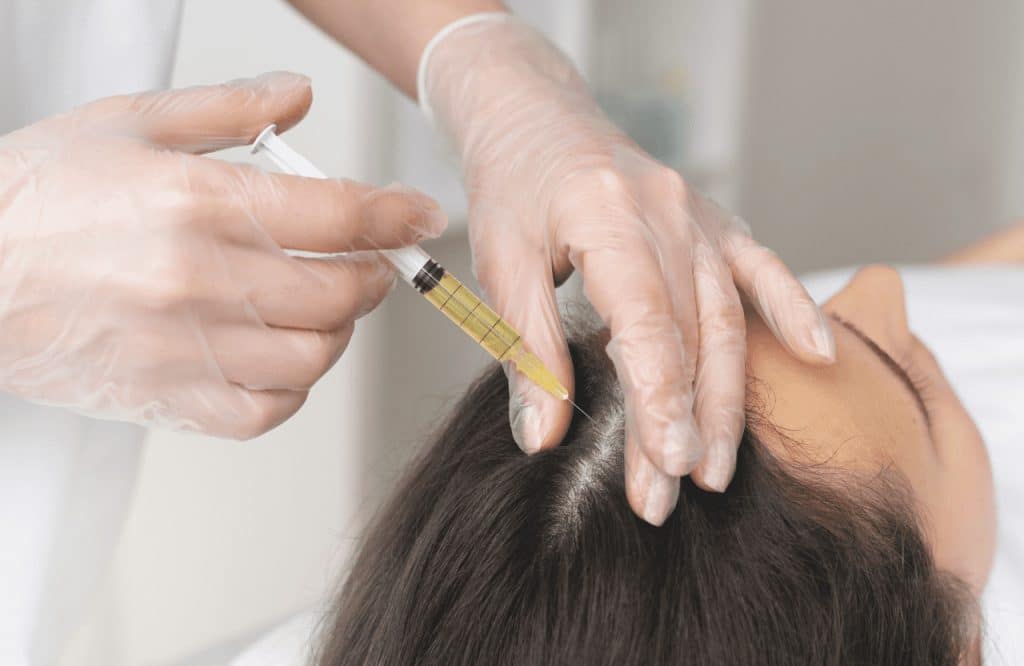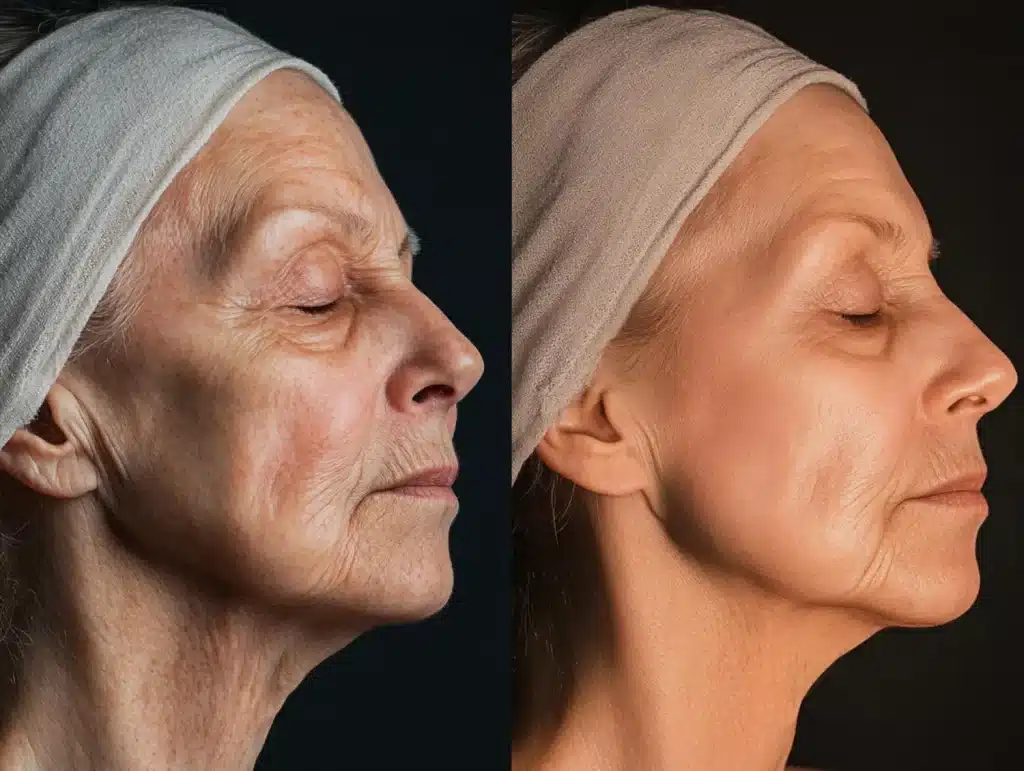According to world statistics, more than half of the world’s population has hair problems – slow growth, excessive hair loss, dandruff, and flaking. Sometimes with age, for various reasons, silky and thick hair turns from a thick mane into a thin “mouse tail.” Of course, this state of affairs is upsetting, but it stimulates the search for the most effective treatments. The good news is that today we have the option to solve this problem.
Injectable hair fillers could be a promising solution for people grappling with hair loss. These innovative treatments combine the principles of dermal fillers with specialized formulations to stimulate hair follicles and promote natural hair regrowth.
Causes of Hair Loss
Doctors-trichologists name many reasons for hair loss and baldness, ranging from hormonal disruptions and internal body problems, ending with the external influence of adverse environmental factors.
The most common and obvious reasons include:
- Hereditary predisposition;
- Reduced immunity;
- Various diseases (oncology, anemia);
- Hormonal changes (testosterone in men, pregnancy, lactation, and menopause in women);
- Malnutrition;
- Unhealthy lifestyle;
- Stress and nervous exhaustion;
- The influence of chemicals and certain medications.
An excessive passion for thermal styling products (hairdryer, curlers), frequent dyeing or perm, and exposure to open sunlight or frost without protection will be no less harmful to the hair.
Dealing with hair loss should begin with identifying the causes and factors that provoked it and only then choosing the most effective treatments. There are a great many of them on the market of cosmetology and pharmaceuticals today.
What Is a Filler for Hair?
Injectable hair filler products are explicitly designed for weakened, brittle hair and people prone to hair loss. Its action is based on improving blood circulation and revitalizing the scalp. This process contributes to the regeneration and activation of the hair follicle and thus inhibits the process of baldness/hair loss.
Hair fillers can improve the hair’s general condition and appearance, accelerate growth, and increase volume. And also it is a helpful tool for people who have transplanted hair; in this case, the action of the filler will be aimed at extending their life cycle.
Main indications for injectable hair fillers:
- Hair loss;
- Thinning hair;
- Androgenetic alopecia
- Weak, brittle, dull, devoid of vitality hair.
Contraindications for the hair filler treatment include:
- Increased sensitivity and individual intolerance to specific components of the drug;
- Pregnancy and lactation;
- Oncological diseases;
- Autoimmune diseases;
- Inflammatory processes of the skin and high body temperature;
- Taking medications that affect the blood coagulation process (anticoagulants, disaggregants);
- Menstrual period;
- Mental illness;
- Epilepsy.
Among the various hair filler options available, DR. CYJ HAIR FILLER is one of the most notable contenders. This product is developed with a unique formula and combines the expertise of dermatology and biotechnology to offer a comprehensive solution for hair restoration. This treatment uses the regenerative potential of peptides and nutrients, aiming to address the underlying causes of hair loss and its cosmetic concerns.
The distinguishing factor of DR. CYJ HAIR FILLER lies in its composition. It is formulated with a specific blend of peptides that have been carefully chosen for their ability to stimulate hair follicles, increase blood flow to the scalp, and improve the overall health of the hair and scalp environment. These peptides act as messengers, communicating with cells to encourage regrowth and rejuvenation. Additionally, vitamins and minerals in the formula further support the nourishment of hair follicles, potentially leading to stronger, thicker, and healthier hair.
Furthermore, the peptides in DR. CYJ HAIR FILLER have the potential to counteract the effects of dihydrotestosterone (DHT), a hormone associated with hair loss in individuals genetically predisposed to pattern baldness. This treatment can prevent further hair thinning and loss by inhibiting the negative impact of DHT on hair follicles.
What To Expect From The Procedure?
This procedure in specific, is a course of micro-injections applied directly into the scalp. When the filler solution enters the cells, the active elements begin to act on the hair follicles. In the process, the condition of the scalp noticeably improves, alongside hair growth acceleration. The drug used in the treatment helps to increase the speed of micro-circulation and stops cell death.
Hair fillers often combine bio-active peptides, vitamins, minerals, and other essential nutrients. Peptides, in particular, are pivotal as signaling molecules that can stimulate cellular activity and promote hair follicle health. By enhancing blood circulation and providing necessary nutrients directly to the hair follicles, injectable hair fillers aim to create an optimal environment for natural hair regrowth.
Using hair fillers in combination with other means with similar indicators is recommended to achieve the maximum effect.
Benefits and Considerations
Injectable hair fillers present a range of potential benefits for both patients and medical professionals that include the following:
- Injectable hair fillers provide a non-surgical option for people who may not be ready or suitable candidates for more invasive hair restoration procedures.
- The precise nature of injectable hair fillers allows targeted treatment in areas of concern, ensuring that the solution directly reaches the hair follicles. This localized approach minimizes the potential for systemic side effects.
- Medical professionals can tailor treatment plans based on individual patient needs and goals. The versatility of the action of injectable hair fillers enables personalized solutions that align with patient expectations.
- Injectable hair fillers can complement other hair restoration modalities, such as oral medications and topical treatments. Combining approaches can lead to synergistic effects and improved outcomes.
- Unlike surgical hair restoration procedures, injectable hair fillers typically involve minimal downtime. Patients can resume their daily activities very soon after the treatment.
However, it’s essential to consider certain aspects:
- Patient responses to injectable hair fillers can vary. While some individuals may experience significant hair regrowth, others might see more modest results. Managing patient expectations and discussing potential outcomes is essential during the preliminary consultation with the patient.
- Achieving optimal results may require multiple treatment sessions. Doctors must guide patients through the expected treatment schedule to ensure they clearly understand the process.
- It is essential to instruct the patient that after the treatment, they should not touch the scalp with their hands, not rub the injection area, not wash their hair for the first 12 hours after the procedure, and not dye their hair 7-10 days after and before the procedure. Also, they need to use gentle hair cleansers during the whole treatment.
Conclusion
Hair filler injections offer a compelling alternative for people seeking non-surgical hair restoration solutions by harnessing the power of bioactive peptides and essential nutrients, stimulating hair follicles, and creating a conducive environment for natural hair regrowth.
With advancements in hair treatment technology and a growing understanding of hair follicle biology, injectable hair filler products like DR. CYJ HAIR FILLER could pave the way for a new stage of accessible and patient-centered hair restoration. As technology advances, we can anticipate further refinements in the composition of these fillers, leading to enhanced efficacy and reduced treatment timelines.
FAQ
How long do hair fillers last?
Fillers for hair can have different longevity depending on the specific product used, the individual’s response to the treatment, and the underlying cause of hair loss.
The effects of injectable hair fillers can last from a few months to a year or more. Patients may need to undergo repeat sessions at specific intervals to maintain the desired level of hair regrowth.
Is it safe to use a hair filler treatment?
A hair filler treatment is considered a safe procedure. Complications are limited to mild skin irritation and redness immediately after filler application, but they are temporary and often disappear within three days.
What is the process of hair fillers?
Using injectable hair fillers to promote hair growth typically involves several steps, from the initial consultation to the actual treatment sessions. Here’s a general overview of the process:
- Consultation – doctor assesses the patient’s medical history, the cause of their hair loss, and their health condition to determine if they are a suitable candidate for the treatment. They also discuss the expectations and potential outcomes.
Next, the doctor examines the patient’s scalp and hair follicles to determine the areas that require treatment. After that, the doctor creates a personalized treatment plan that outlines the number of sessions needed, the injection sites, and the amount of filler to be used.
- On the day of the treatment, the injection sites must be cleansed and possibly marked for precision. The medical professional may apply a topical numbing cream to minimize discomfort during the injections. Using a fine needle, the medical professional carefully injects the solution into the targeted areas of the scalp.
- After the injections are completed, the doctor must provide instructions for post-treatment care. This could include avoiding certain activities that might increase the risk of complications (such as heavy exercise) and using specific hair care products.
References
Kiani, M. T., Higgins, C. A., & Almquist, B. D. (2018). The Hair Follicle: An Underutilized Source of Cells and Materials for Regenerative Medicine. ACS biomaterials science & engineering, 4(4), 1193. https://doi.org/10.1021/acsbiomaterials.7b00072.
Peng, H., & Hsien-Li Peng, P. (2020). HA Filler Injection and Skin Quality–Literature Minireview and Injection Techniques. Indian Journal of Plastic Surgery: Official Publication of the Association of Plastic Surgeons of India, 53(2), 198-206. https://doi.org/10.1055/s-0040-1715545.
Kiani, M. T., Higgins, C. A., & Almquist, B. D. (2018). The Hair Follicle: An Underutilized Source of Cells and Materials for Regenerative Medicine. ACS biomaterials science & engineering, 4(4), 1193. https://doi.org/10.1021/acsbiomaterials.7b00072.
Hair Filler. Hyaluronic acid filler against hair loss. The Body Clinic. https://www.bodyclinic.nl/en/treatments/fillers/hair-fillers/.
Hair Fillers. 7 Dimensions Medical Centre. October 2021. https://7dmc.ae/hair-fillers/.





















